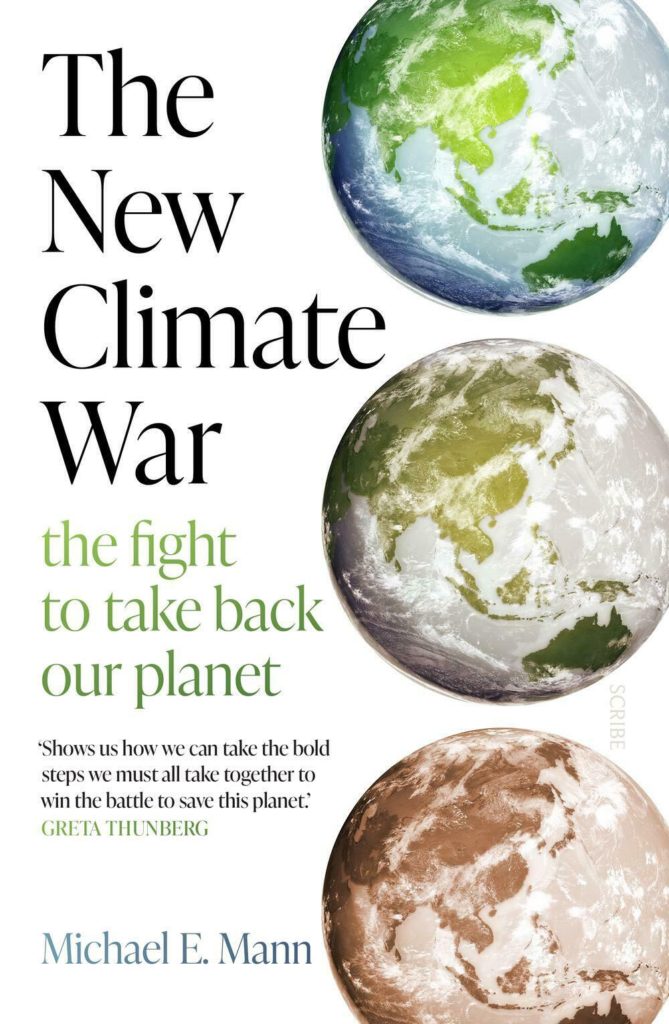There is a new type of warrior emerging in the ongoing tussle between the evidence-based science of climate change and the diversionary tactics of fossil-fuel companies and political supporters. This rare but growing cohort in the winnable battle against climate change denial are scientists who can effectively communicate about complex science. They’re also willing to engage in pitched social media, news media, and other battles against the trolls, bots, and uber-conservative news outlets who are telling us to move along … nothing to see here.

One of the leaders of this new battle front is Dr. Michael E. Mann, a distinguished professor of atmospheric science at Penn State. Working with two other scientists, he was the originator of the famed “hockey stick” graph that in 1999 showed us the sharp rise in atmospheric temperatures over the past 1,000 years. It is perhaps the most easily understood, most frequently used visual depiction of why we need to act against manmade climate change.
Dr. Mann has previously authored or co-authored four books on climate change, each time providing us with the empirical science behind relentlessly advancing temps and sounding the alarm we need to hear. He is constantly called on to speak around the world. And he has developed a reputation as a no-nonsense, often amusing, and blunt combatant against the social media misinformation campaigns waged by fossil fuel supporters, oil-producing nations, conservative Republicans, and news media outlets such as Fox News. I have been following Dr. Mann on Twitter for some time. His tweets are entertaining, informative … and prolific. As I write this, he has tweeted or re-tweeted over 35 times in the last 24 hours. He touched on topics ranging from the bizarre Republican “green new deal/alternate energy source” blame game in the wake of the tragic Texas storm to his ongoing news media interviews on climate change and his new book.
***
With his fifth and latest book, “The New Climate Wars,” (released Jan. 12) Dr. Mann is taking his efforts to a new level. The new book represents his sharpest blow yet against climate change denial. While it contains the accepted and proven science to support the reality of climate change, it also raises the stakes in several new areas. Dr. Mann draws the curtain back on the well-funded communication and public relations campaigns designed to shed doubt on climate change and to attack leading public and scientific figures, including him. As someone who has spent a career working in journalism, communications, and public relations I found this part of his new book fascinating.

Some elements of Dr. Mann’s discussion of PR and communications are not new but are bolstered with revelations sure to shock even the most ardent of environmental activists. You might not know, for example, that Exxon’s own researchers as far back as the 1970s knew continued burning of fossil fuels would elevate atmospheric levels of carbon dioxide dramatically and could raise average global temperatures by 2 to 3 degrees centigrade—and this warming could happen within 5 to 10 years. Exxon not only didn’t act on the conclusions of its own scientists and others in the field, but the company also launched a long-term PR effort to cause confusion about climate change and the role of fossil fuels.
Think of tobacco companies and their legendary (and now admitted) PR efforts to bolster cigarette sales—despite well-known connections of the habit to lung cancer. The fossil fuel companies employed the same game plan.
For me, the most startling revelation involved the famous anti-littering “crying Indian” public service TV ad in the early 1970s. Those of us who saw the ad were so moved by it we stopped littering. What I didn’t know—and I wasn’t alone—was that the ad was a clever creation of beverage and packaging companies. They launched the effort to deflect attention from early efforts to pass bills to require deposits on cans and bottles, removing that trash from waste and garbage streams. The strategy worked. There is still no national bottle bill law today. Only 10 states have these laws.
To add insult to injury, the actor in the commercial was not even Native American. His name was Espera de Corti, an Italian American well-known for playing Native Americans.
In his book, Dr. Mann uses this example to draw our attention to today’s diversionary tactics. Fossil-fuel companies and their fervent conservative supporters want us to focus on individual actions we should be taking to help slow or reverse the amount of carbon dioxide pumped into the atmosphere. Through direct or indirect PR efforts, they encourage us to drive cars with better mileage, take fewer airline flights, use alternative energy sources, and generally reduce our carbon footprint. And when we do take those airline flights, they say, we should buy carbon offsets. Those same groups are quick to shame people who don’t take these and other personal greenhouse gas-limiting actions. There is absolutely nothing wrong with taking these steps. But by themselves these measures will not save us from the potential catastrophic damage of climate change.
What’s needed, Dr. Mann and other scientists and activist argue, are widespread systemic changes, such as better government regulation and policies, significant industry steps such as electric or higher-mileage cars, an array of proven alternate energy sources, and carbon pricing. All of these and other major changes are challenged by fossil fuel providers and their supporters. Who can blame them? They have a massive revenue stream based on selling oil, coal, and natural gas. Dr. Mann asks the question: Why not do both? Take individual action and become an activist for the wider-reaching changes we need. It’s pretty simple when you step back and examine the big picture. The confusion we see (and the shame we experience when we don’t take personal action) is exactly what climate change opponents and deniers want.
Like the crying Indian ad, our attention is diverted from what really should be happening.
***
While Dr. Mann’s new book is rich with points like these, I’ll share just two more.
Those who deny the reality of climate change want us to give up because they want us to believe we’re already past the point of no return. There’s nothing we can do now, they say, so the focus should be on adapting to this new world. Build higher sea walls and dikes. Use water more efficiently. Change building codes to harden them for the stronger storms. Perhaps, as Dr. Mann says humorously, we’ll develop gills and fins, maybe even fireproof skin. The point is if we believe the result is inevitable, we won’t do anything to stem carbon dioxide emissions now. Dr. Mann and other scientists argue that we still have time to slow down, flatten out, and eventually reverse carbon dioxide emissions that result from burning fossil fuels. Don’t fall for the deniers’ claims.
Finally, I’ll call it the coal mining point. As our former president and others have stated on many occasions, we must do everything we can to save the livelihoods of coal miners and the companies they work for. As a reminder, not only does burning coal emit carbon dioxide but it also produces the sulfur dioxide behind acid rain, the particulate pollution behind smog and other forms of air pollution, and nitrogen oxides, which also contribute to air pollution and respiratory illnesses. And there is no such thing as “clean coal.”
Whether we like it or not the constant state of our world is change. Horse and buggies were replaced by cars and trains. Candles gave way to electric lights. One of my favorites stories in this vein was my own experience working as a senior manager in public relations at Verizon and its predecessor companies. Up until late in the 20th century pay phones were an important part of our business. From street corners to airline terminals, they were a staple in our lives and the way we communicated when we were away from home or the office. Enter the handheld cell phone. Within a short time, the pay phone business within Verizon—a multimillion-dollar revenue source—withered away. No one tried to save them. Customers wanted more portability. We gave it to them, even if it meant killing off another part of our business. We closed the large centers where we used to count coins from pay phones, and we migrated those and other pay phone-related employees to new jobs.
***
My conclusion? This newest book from noted climate scientist Michael Mann is essential reading. In a world beset by problems caused by the non-stop burning of fossil fuels since the 19th century, this book should rest beside our computers as we live our lives each day. It is, in my opinion, an indispensable aid not only in understanding climate change but also in mapping out how to take individual action and engage in activism to spur the significant systemic change needed to arrest the warming of our globe. And it’s well written.

Sounds like a very interesting book. I recently heard that, I think was the EPA, if nothing was done the ski season would be only 6 weeks by 2050.
Bill — I certainly hope we don’t see a ski, snowshoeing, cross-country skiing, ice skating season that short!
Great review Mark – so many good points to explore, will check out the book.
Thank you, Mr. Mann, and thank you for posting, Michael Boyer! When will the necessary actions start? My most urgent demand is to stop production of automobiles in Germany in order to reduce waste and waste heat significantly